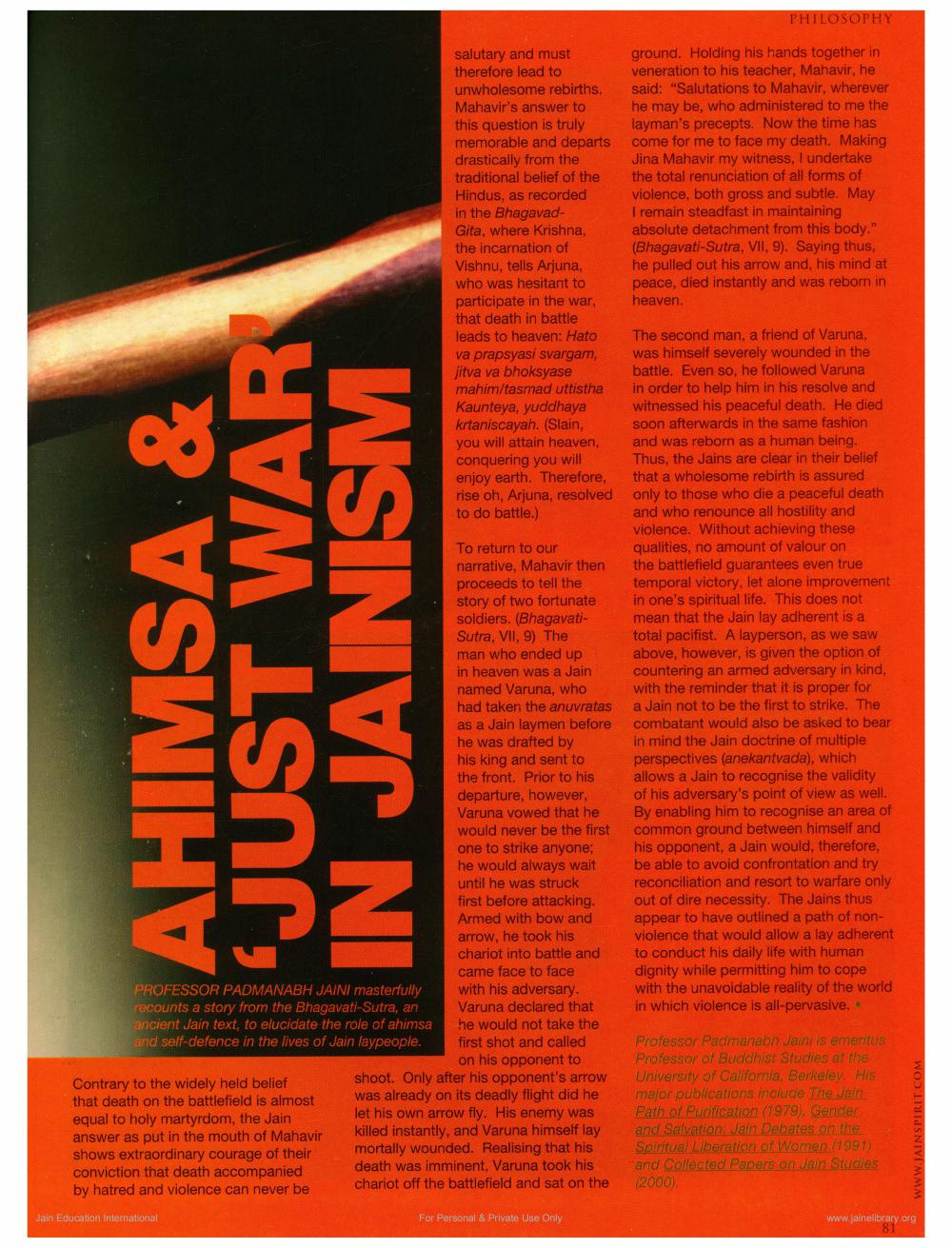________________
PHILOSOPHY
salutary and must therefore lead to unwholesome rebirths. Mahavir's answer to this question is truly memorable and departs drastically from the traditional belief of the Hindus, as recorded in the BhagavadGita, where Krishna, the incarnation of Vishnu, tells Arjuna. who was hesitant to participate in the war, that death in battle leads to heaven: Hato va prapsyasi svargam, jitva va bhoksyase mahim/tasmad uttistha Kaunteya, yuddhaya krtaniscayah. (Slain, you will attain heaven, conquering you will enjoy earth. Therefore, rise oh, Arjuna, resolved to do battle.)
ground. Holding his hands together in veneration to his teacher, Mahavir, he said: "Salutations to Mahavir, wherever he may be, who administered to me the layman's precepts. Now the time has come for me to face my death. Making Jina Mahavir my witness, I undertake the total renunciation of all forms of violence, both gross and subtle. May I remain steadfast in maintaining absolute detachment from this body." (Bhagavati-Sutra, VII, 9). Saying thus, he pulled out his arrow and his mind at peace, died instantly and was reborn in heaven.
To return to our narrative, Mahavir then proceeds to tell the story of two fortunate soldiers. (BhagavatiSutra, VII, 9) The man who ended up in heaven was a Jain named Varuna, who had taken the anuvratas as a Jain laymen before he was drafted by his king and sent to the front. Prior to his departure, however, Varuna vowed that he would never be the first one to strike anyone; he would always wait until he was struck first before attacking. Armed with bow and arrow, he took his chariot into battle and
came face to face PROFESSOR PADMANABH JAINI masterfully with his adversary. recounts a story from the Bhagavati-Sutra, an Varuna declared that ancient Jain text, to elucidate the role of ahimsa he would not take the and self-defence in the lives of Jain laypeople. first shot and called
on his opponent to Contrary to the widely held belief
shoot. Only after his opponent's arrow that death on the battlefield is almost
was already on its deadly flight did he equal to holy martyrdom, the Jain
let his own arrow fly. His enemy was answer as put in the mouth of Mahavir
killed instantly, and Varuna himself lay shows extraordinary courage of their
mortally wounded. Realising that his conviction that death accompanied
death was imminent, Varuna took his by hatred and violence can never be
chariot off the battlefield and sat on the
AHIMSA & "JUST WAR IN JAINISM
The second man, a friend of Varuna, was himself severely wounded in the battle. Even so, he followed Varuna in order to help him in his resolve and witnessed his peaceful death. He died soon afterwards in the same fashion and was reborn as a human being. Thus, the Jains are clear in their belief that a wholesome rebirth is assured only to those who die a peaceful death and who renounce all hostility and violence. Without achieving these qualities, no amount of valour on the battlefield guarantees even true temporal victory, let alone improvement in one's spiritual life. This does not mean that the Jain lay adherent is a total pacifist. A layperson, as we saw above, however, is given the option of countering an armed adversary in kind, with the reminder that it is proper for a Jain not to be the first to strike. The combatant would also be asked to bear in mind the Jain doctrine of multiple perspectives (anekantvada), which allows a Jain to recognise the validity of his adversary's point of view as well. By enabling him to recognise an area of common ground between himself and his opponent, a Jain would, therefore, be able to avoid confrontation and try reconciliation and resort to warfare only out of dire necessity. The Jains thus appear to have outlined a path of nonviolence that would allow a lay adherent to conduct his daily life with human dignity while permitting him to cope with the unavoidable reality of the world in which violence is all-pervasive.
Professor Padmanabh Jainis emeritus Professor of Buddhist Studies at the University of California, Berkeley. His major publications include The Jain Path of Puntication (1979), Gender and Salvation Jain Debates on the Spiritual Liberation of Women (1991) and Collected Papers on Jain Studies (2000)
WODINIDSNIVIMMM
Jain Education International
For Personal & Private Use Only
www.ainelibrary.org




